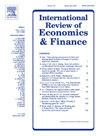如何通过发展绿色金融实现清洁能源转型?来自中国的证据
IF 5.6
2区 经济学
Q1 BUSINESS, FINANCE
引用次数: 0
摘要
本研究利用2003 - 2019年中国30个省区的面板数据,考察了绿色金融与清洁能源转型之间的关系。与现有的研究依赖于单一指标不同,我们为CET开发了一个全面的多维评估框架。研究结果表明,GF对CET的影响是有条件的,但具有显著性:从区域上看,GF对沿海和低能耗地区的影响强于内陆和高能耗地区;此外,环境法规和能源禀赋调节了这种关系,因为命令与控制、自愿或基于信息的法规放大了GF的贡献。相反,市场化调控的抑制作用较弱,过度依赖能源禀赋挤占绿色投资,不利于绿色发展。GF的规模(SFIN)和效率(EFIN)表现出不同的动态——SFIN通过扩大绿色资本可用性显著推动CET,而EFIN在大多数情况下影响不显著。在市场化程度较高的省级地区,中小企业金融市场和中小企业金融市场都对CET有贡献。然而,只有SFIN在低市场化地区发挥作用,在这些地区,fin受到行政干预和制度薄弱的约束。因此,需要因地制宜的政策来利用GF在推进CET方面的潜力。本文章由计算机程序翻译,如有差异,请以英文原文为准。
How to achieve clean energy transition through developing green finance? Evidence from China
This study examines the relationship between green finance (GF) and clean energy transition (CET) using panel data from 30 Chinese provincial regions from 2003 to 2019. Unlike extant research that relied on single metrics, we develop a comprehensive multidimensional evaluation framework for CET. The findings reveal that GF is a significant but conditional driver of CET and its impact is shaped by multiple contextual factors: Regionally, GF exerts a stronger effect in coastal and low energy consumption areas than that in inland and high energy consumption regions. Furthermore, environmental regulations and energy endowments moderate this relationship, as command-and-control, and voluntary or information-based regulations amplify GF's contribution. Conversely, market-oriented regulation has a weak dampening effect, while excessive energy endowment reliance undermines GF by crowding out green investment. GF's scale (SFIN) and efficiency (EFIN) exhibit distinct dynamics—SFIN significantly drives CET via expanded green capital availability, whereas EFIN shows nonsignificant effects in most cases. Moreover, marketization levels differentiate their roles: Both SFIN and EFIN contribute to CET in high marketization provincial regions. However, only SFIN functions in low marketization regions, where EFIN is constrained by administrative interference and weak institutions. Thus, context-specific policies are needed to leverage GF's potential in advancing CET.
求助全文
通过发布文献求助,成功后即可免费获取论文全文。
去求助
来源期刊
CiteScore
7.30
自引率
2.20%
发文量
253
期刊介绍:
The International Review of Economics & Finance (IREF) is a scholarly journal devoted to the publication of high quality theoretical and empirical articles in all areas of international economics, macroeconomics and financial economics. Contributions that facilitate the communications between the real and the financial sectors of the economy are of particular interest.

 求助内容:
求助内容: 应助结果提醒方式:
应助结果提醒方式:


